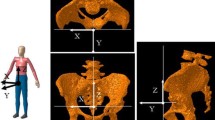Abstract
Purpose
Reduced range of motion (ROM) in flexion and internal rotation are associated with impaired activities of daily living (ADL) after rotational acetabular osteotomy (RAO). This study focused on the morphological variation of the anterior inferior iliac spine in developmental dysplasia of the hip (DDH) and its impact on post-operative bony ROM after RAO. This study aimed to investigate the association between bony ROM after RAO and pre-operative morphological factors of the pelvis and femur, including a positional variation of the anterior inferior iliac spine.
Methods
Bony ROM in 52 patients with DDH was assessed after virtual RAO using computed tomography (CT). Post-operative acetabular coverage was set at lateral and anterior centre-edge angles of 30° and 55°, respectively. The position of the anterior inferior iliac spine was classified as higher or lower.
Results
Multiple regression analysis revealed that the lower anterior inferior iliac spine and higher femoral neck shaft angle were significantly associated with the lower flexion angle after RAO. Lower femoral anteversion, higher femoral neck shaft angle and higher alpha angle at the anterosuperior part were significantly associated with lower internal rotation angle at 90° flexion after RAO.
Conclusion
Therefore, morphological variation of the anterior inferior iliac spine affected bony ROM in flexion and that of the femoral neck affected bony ROM in internal rotation at flexion after RAO.


Similar content being viewed by others
References
Ninomiya S (1989) Rotational acetabular osteotomy for the severely dysplastic hip in the adolescent and adult. Clin Orthop Relat Res 247:127–137
Nakamura S, Ninomiya S, Takatori Y et al (1998) Long-term outcome of rotational acetabular osteotomy: 145 hips followed for 10-23 years. Acta Orthop Scand 69:259–265
Imai H, Kamada T, Takeba J et al (2014) Anterior coverage after eccentric rotational acetabular osteotomy for the treatment of developmental dysplasia of the hip. J Orthop Sci 19:762–769
Hamada H, Takao M, Nakahara I et al (2016) Hip range-of-motion (ROM) is less than normal after rotational acetabular osteotomy for developmental dysplasia of the hip. A simulated ROM analysis. J Orthop Res 34(2):217–223
Siebenrock KA, Schöll E, Lottenbach M, Ganz R (1999) Bernese periacetabular osteotomy. Clin Orthop Relat Res 363:9–20
Nakahara I, Takao M, Sakai T et al (2011) Gender differences in 3D morphology and bony impingement of human hips. J Orthop Res 29:333–339
Nakahara I, Takao M, Sakai T et al (2014) Three-dimensional morphology and bony range of movement in hip joints in patients with hip dysplasia. Bone Joint J 96:580–589
Hetsroni I, Poultsides L, Bedi A et al (2013) Anterior inferior iliac spine morphology correlates with hip range of motion: a classification system and dynamic model. Clin Orthop Relat Res 471:2497–2503
Larson CM, Giveans MR, Samuelson KM et al (2014) Arthroscopic hip revision surgery for residual Femoroacetabular impingement (FAI): surgical outcomes compared with a matched cohort after primary arthroscopic FAI correction. Am J Sports Med 42:1785–1790
Crowe JF, Mani VJ, Ranawat CS (1979) Total hip replacement in congenital dislocation and dysplasia of the hip. J Bone Joint Surg Am 61:15–23
Wiberg G (1939) Studies on dysplastic acetabula and congenital subluxation of the hip joint, with special reference to the complication of osteo-arthritis. Acta Chir Scand 83:29–38
Tönnis D (1976) Normal values of the hip joint for the evaluation of x-rays in children and adults. Clin Orthop 119:39–47
Dandachli W, Najefi A, Iranpour F et al (2012) Quantifying the contribution of pincer deformity to femoro-acetabular impingement using 3D computerised tomography. Skelet Radiol 41:1295–1300
Sugano N, Noble PC, Kamaric E (1998) A comparison of alternative methods of measuring femoral anteversion. J Comput Assist Tomogr 22:610–614
Nötzli HP, Wyss TF, Stoecklin CH et al (2002) The contour of the femoral head-neck junction as a predictor for the risk of anterior impingement. J Bone Joint Surg (Br) 84:556–560
Landis JR, Koch GG (1977) The measurement of observer agreement for categorical data. Biometrics 33:159–174
Tannast M, Kubiak-Langer M, Langlotz F et al (2007) Noninvasive three-dimensional assessment of femoroacetabular impingement. J Orthop Res 25:122–131
Steppacher SD, Zurmühle CA, Puls M et al (2015) Periacetabular osteotomy restores the typically excessive range of motion in dysplastic hips with a spherical head. Clin Orthop Relat Res 473:1404–1416
Fabricant PD, Sankar WN, Seeley MA et al (2016) Femoral deformity may be more predictive of hip range of motion than severity of Acetabular disease in patients with Acetabular dysplasia: an analysis of the ANCHOR cohort. J Am Acad Orthop Surg 24:465–474
Beaulé PE, Dowding C, Parker G, Ryu JJ (2015) What factors predict improvements in outcomes scores and reoperations after the Bernese periacetabular osteotomy? Clin Orthop Relat Res 473:615–622
Acknowledgements
The authors would like to thank Dr. Keisuke Uemura (Department of Orthopedic Medical Engineering, Osaka University Graduate School of Medicine, Suita, Japan) for his assistance analysing the reproducibility of the morphological study.
Author information
Authors and Affiliations
Corresponding author
Ethics declarations
Conflict of interest
Hidetoshi Hamada, Masaki Takao, Takashi Sakai, and Nobuhiko Sugano declare that they have no conflict of interest.
Ethical approval
All procedures performed in studies involving human participants were in accordance with the ethical standards of the institutional and/or national research committee and with the 1964 Declaration of Helsinki and its later amendments or comparable ethical standards. For this type of study, formal consent is not required.
Rights and permissions
About this article
Cite this article
Hamada, H., Takao, M., Sakai, T. et al. Morphological variation of the anterior inferior iliac spine affects hip range of motion in flexion after rotational acetabular osteotomy. International Orthopaedics (SICOT) 42, 1247–1252 (2018). https://doi.org/10.1007/s00264-017-3673-1
Received:
Accepted:
Published:
Issue Date:
DOI: https://doi.org/10.1007/s00264-017-3673-1




